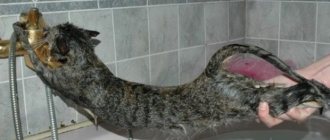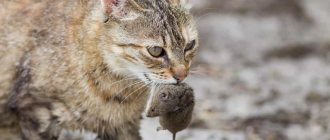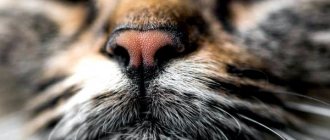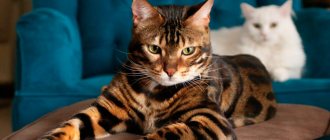There are several popular cat breeds that originate from Russia. For example, Russian blue cats are known all over the world, but the Ussuri cat rarely finds itself as a companion. Russian cat breeds differ both in appearance and in temperament, because they appeared in different parts of Russia from different ancestors.
10 Russian cat breeds
If you want to adopt a rare and unusual cat, it is better to first meet a representative of the breed. You will be able to understand how her character will fit with your lifestyle.
Kurilian Bobtail
The Kurilian Bobtail is a naturally occurring breed. These cats have lived for more than 200 years on Sakhalin Island and the Kamchatka Peninsula. They also live in the Kuril archipelago, connecting Russia and Japan. They look like predators, but in fact they are calm and affectionate. However, their instincts are well developed and they have high energy.
General characteristics
- HEIGHT : 23 – 30 cm
- WEIGHT : 4 – 8 kg
- APPEARANCE : soft, silky short to medium length coat; characteristic short tail; color red or gray with stripes
Key Features
“Native” cats were always taken as the basis for breeding; some individuals were crossed with wild species of felines, which was reflected in their appearance and character.
An important feature of Russian cat breeds is also their short pedigree (with the exception of the Siberian). It is quite difficult to find a cat with a history of more than four generations; for this reason, some cat breeds are not considered “canned”.
Very often, purebred kittens are sold without documents, as a result, there is a high risk of purchasing an outbred individual. When purchasing a purebred animal, you should always ask for documents and pedigree.
Ural rex
The origins of the Ural Rex breed date back to the pre-war era, but their numbers declined significantly after World War II. The breed gained fame only in the 80s. The official founder of the breed is considered to be the cat Vasily, born in 1988. As a social cat, this breed enjoys being around people and loves children. They are quiet and even-tempered by nature, and this breed is also quite tough and fearless. The breed was officially confirmed only in 2006.
Neva Masquerade
The Neva Masquerade is considered a descendant of the Siberian cat; the name appeared due to the unusual color of its face, as if it were wearing a carnival mask.
Another advantage of the breed is its non-standard color-point coat with bright eyes. Neva cats are very affectionate and sensitive, taking their place among favorite pets.
The cost starts from 2 thousand rubles. for a kitten without a pedigree and ends at 25 thousand rubles.
Characteristics, breed standard
The Russian Blue is registered in all known felinological associations.
A standard is a detailed description of the external appearance of a cat, sometimes its character, proposed by one or another felinological organization as a standard for breeders. The characteristics of any cat breed are almost completely the same across different associations. But with the Russian Blue everything is more complicated.
An expert from the American international felinological association TICA, Amanda Bryan, emphasizes that the Russian breed today has four main varieties, the standards of which are described in different systems:
- North American species - TICA and CFA;
- English subtype - GCCF;
- Scandinavian blue is very similar to American blue, but there are differences;
- European (or Russian) type - FIFe and WCF.
Although generally breeders emphasize two types - American and European.
Russian Blue breed standard for the European type of the WCF system:
- The head is of medium length, the skull is flat. The forehead and nose are straight, forming an obtuse angle at the level of the eyebrows.
- The whiskers are well developed and convex.
- The chin is strong, well developed, more powerful in cats.
- The ears are quite large, wide at the base and slightly pointed at the top, widely spaced, slightly tilted forward. The inner edge is weak, the ear appears transparent.
- The eyes are large, almond-shaped, and widely spaced. Any shade of green, with a bright emerald color being a plus. Kittens up to four months old are blue, changing as the individual grows older.
- Body. The size is medium, the type is muscular, quite strong, but at the same time gracefulness is maintained.
- Neck. Slender, quite long, visually appears shorter due to dense fur.
- The tail is long, proportional to the body, tapering to a rounded tip.
- Wool. Short, dense, double. The main hair and undercoat are the same length.
- The color is always blue with a silver tint (tipping on the tips of the fibers). Preference is given to the middle tone.
- The nose is gray-blue.
- The paws are of medium length, muscular, and quite graceful. The paw pads are pink with a purple tint.
Russian Blue breed standard, American type, TICA system:
- Head. Wedge-shaped with pronounced seven edges. The crown is narrow and straight. The nose is straight, the forehead is flat.
- Ears. Wider at the base, tapering and slightly rounded at the top. The length is almost equal to the width on the skull. Inside the ear there is a small edge and tassels. Set wide apart, covering the side surface of the head, akin to the oriental type.
- The eyes are large and almost round, slanted, oriental type. Always green, the brighter, the more valuable the individual.
- The body is light in build, narrow, long with thin bones. Muscular, but not heavy. Dense wool visually gives a squat appearance. Males are much larger than females.
- The neck is long and slender, the fur hides its length.
- The tail is long, wide at the base, tapering strongly towards the end.
- The coat is double and dense, but soft and silky to the touch.
- The color is bright blue, uniform throughout the body. Shines silver - tipping. Preference is given to a light tone.
- The nose is always charcoal gray.
- The paws are graceful, medium length, flesh-colored, pink pads.
For all felinological systems, the assessment of defects is the same:
- violation of the structure of the head;
- malocclusion;
- sunken or too prominent eyes;
- not straight back or deformed sternum;
- tail curls;
- poor health.
Grounds for disqualifying an animal:
- aggressive behavior or signs of tranquilizer use;
- signs of haircut, dyeing;
- cryptorchidism;
- polydactyly or olidactyly;
- visual impairment;
- umbilical hernia;
- white spots on the body.
These cats are medium in size and light in weight, about three kilograms in females and up to five kilograms in males. They are practically not prone to diseases and natural defects, and have a calm, flexible character.
Peterbald
A young breed bred in St. Petersburg in the 90s of the last century. Peterbald received CFF recognition in 1997.
- Appearance. The body is elongated, flexible, muscles are well developed. Narrow muzzle, large ears, wide-set eyes. They can be completely hairless or have very short fur on the head and paws.
- Character. Playful, sociable cats. They are curious and follow their owner everywhere. They don't like to be alone.
- Attitude towards children: friendly, willingly support joint games.
- Immunity. There is a high risk of colds.
- Typical diseases: rhinotracheitis, pneumonia.
Russian blue cat
This breed is considered one of the most famous and beloved in the world. Its main value lies in the absence of participation of breeders in its breeding; humans only supported the population. According to legend, several centuries ago, Russian English sailors stopping at the port of Arkhangelsk took cats with a unique gray-blue tint of fur on board as a souvenir.
The coat is short, thick, the shade is always the same - gray-blue, slightly shimmering, the character is soft and calm, the kittens are affectionate, playful, sometimes cats can show willfulness and stubbornness.
Prices vary between 8-35 thousand rubles.
Care and maintenance
Does not like loneliness or change of place of residence.
The breed does not require special care. But, like all cats, she needs to be brushed. Brush the coat with special soft natural bristle brushes (furminators) or a rubber glove 2 times a week. During the molting period - 3 times.
Bathing and nail trimming are carried out as needed. The sharp tips of the claws are trimmed twice a month with special pruning shears. It is advisable to bathe the cat only after the fur is dirty or use dry shampoo.
The owner needs to inspect the pet’s ears and, if necessary, clean them with a cotton pad moistened with water.
Periodically you need to inspect the animal's fur for lice, fleas, ticks and other parasites, especially if the cat is often outdoors.
Hygiene
Like all cats, the Russian Blue is clean and spends a lot of time grooming its coat . She is easy to litter train. The owner must constantly monitor the cleanliness of the cat's litter box.
It is advisable to use wood filler. If the cat finds the litter box not clean enough, it can use other places in the house for its needs. It is necessary to regularly wash the dishes from which the animal eats and drinks.
Important! The breed is characterized by cleanliness.
Diet and feeding
Like all cats, the Russian Blue is clean and devotes a lot of time to grooming its coat.
It is difficult for humans to calculate the required optimal amount of nutrients and vitamins in food prepared for a cat, so veterinarians recommend purchasing commercial food.
For nutrition, you need to select high-quality premium and super-premium food (Royal Canin, Proplan, Hills). This food contains all the necessary micro- and macroelements, balanced nutrients.
It is not permissible to feed your pet food from the table.
The frequency of feeding depends on the age of the cat:
- 3-4 months – 5 times a day.
- Up to six months - 4 times a day.
- 7-12 months – 3 times a day.
- Adult pets one year and older - twice a day.
Education and training
Thanks to its intelligence and aristocratic manners, the Russian Blue is easy to train. It will not be difficult for the owner to accustom her to water procedures, a tray, a scratching post, and a ban on climbing on the table.
If desired, the cat can be taught simple commands: “Give me your paw!”, “Come to me!” To do this, alternate short lessons and treats with long rests.
Be sure to read:
Cymrik cat breed: description of the breed, photo
Life expectancy and typical diseases
Cats of this breed were not artificially bred, therefore they are distinguished by good health and immunity. They live on average 15-20 years.
Russian Blue cats live on average 15-20 years
Life expectancy depends on nutrition, care, and genetic predisposition to diseases (virtually absent).
Typical diseases do not occur in Russian Blue cats. Rarely, kinks in the tail, defects in coat color, and typical cat diseases (helminth infections, colds, obesity, allergies) may be observed.
Castration and sterilization
If the owner does not intend to breed the breed, then the best solution to satisfy the pet’s reproductive instinct would be castration or sterilization. The optimal age for sterilization is 1-1.5 years (sometimes 9-11 months).
Sterilization is a surgical procedure involving ligation of the fallopian tubes in cats and the seminal ducts in cats, but the genitals are not removed.
Sterilization does not affect sexual desire, but eliminates the possibility of having offspring. Castration is the complete surgical removal of reproductive organs.
Both operations are painless and safe; the main thing is to choose a qualified clinic with experienced veterinarians. It is advisable not to sterilize a cat before her first pregnancy.
Don Sphynx
The first kitten of the Don Sphynx with a bald back was taken from children on the street by a resident of Rostov-on-Don; the first offspring of the cat Varvara was also hairless, which gave rise to the development of a new breed. As a result of further breeding, another line of Sphynxes appeared, unrelated to the Canadian ones.
Representatives of this breed at first glance are very similar to their foreign counterparts, but a professional breeder or an experienced fancier will immediately notice the differences due to a different set of genes.
Kittens can be born completely bald, covered with short down or dense thick hair. The body structure is also lighter compared to Canadians, this breed is distinguished by a different eye shape and other little details, this is a real Russian breed that has earned worldwide recognition.
A kitten can be purchased for 9-30 thousand rubles.
Siberian
The Russian cat breed originated in the Siberian forests as a result of crossing domestic breeds with wild steppe ones. Siberian cats are distinguished by their strong physique and thick, dense fur coat; due to these two factors, individuals look like real giants.
The weight of an adult animal can reach 12 kg, the size of cats is somewhat smaller, but they still remain quite strong, and at the same time harmoniously built cats.
The main feature of the breed is the coat; it is long, the undercoat is short, dense and thick, perfectly protecting the individual from the cold. The obligatory attributes of the breed are thick pants and a collar, hair between the toes, tufts on the ears; Siberian cats are distinguished by self-sufficiency, intelligence, strong and bright character.
A Siberian kitten can be bought for 10 thousand rubles.
Peterbald
Peterbald has a second name - the St. Petersburg Sphynx; these cats have a naked body. Characteristics of the breed:
- mind;
- playfulness;
- devotion;
- friendliness to both people and other animals.
The Peterbalds love children. They allow themselves to be picked up and stroked. Sphinxes treat all family members equally well.
Ussuri
Ussuri have a strong and proportional body with developed muscles. The tabby's color ranges from golden brown to fawn. At the ends of the ears there are tufts like those of a lynx.
The average life expectancy of Ussuri cats is 12-16 years. By character they resemble wild ones, they are independent and freedom-loving. They need a lot of space, which will be their hunting territory. This breed is not suitable for communicating with children, as they do not like it when someone invades their territory.











